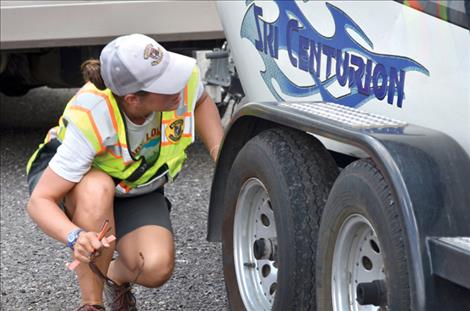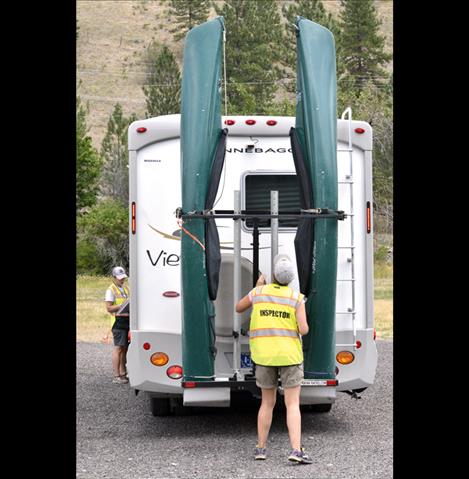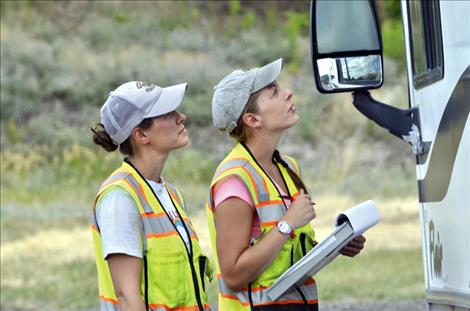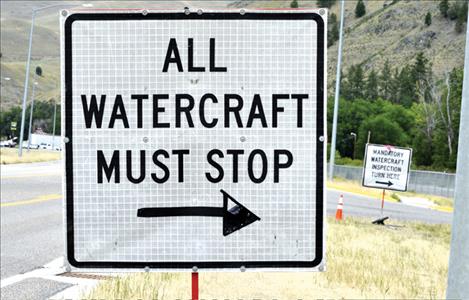Preventing an invasion
Hey savvy news reader! Thanks for choosing local.
You are now reading
1 of 3 free articles.
RAVALLI – The sneaky little pests are the stuff of nightmares. Well, maybe, mostly the nightmares of those with the Aquatic Invasive Species team, which is part of Montana Fish, Wildlife and Parks.
Those pests can hitch a ride on any watercraft. The idea is to catch them before they escape into another body of water and reproduce in staggering numbers. The AIS created several check stations all over Montana to stop that from happening, and the nearest station in this area is located in Ravalli.
On a Thursday afternoon, a recreational vehicle from Utah pulled into the Ravalli check station with a ski boat. They were headed to Flathead Lake. Two inspectors in orange vests were waiting nearby.
Inspector Tabitha Espinoza ran her hands over the smooth edges of the boat during an inspection. She ducked down next to the ground to check underneath the boat. She looked over every surface of the watercraft including the motor and the drain. It took less than five minutes. Thankfully, nothing was there.
“If the boat is caked in mud, it takes a little longer,” she said.
Inspector Jorri Dyer collected a bit of information from the driver about where the boat has been. The inspectors don’t generally look for specific species, although they do keep an eye out for zebra and quagga mussels.
“They pose a huge threat to Montana if introduced and are easily transported by boats, trailers and gear,” Tom Boos, AIS program coordinator, later explained. “We also look for any aquatic vegetation. Also, we look for and investigate standing water, which can harbor (aquatic invasive species).”
And they have found a few invaders this year.
“We have intercepted one mussel fouled boat thus far,” he said. “Ten instances of vegetation and standing water.”
The cleaning process begins on site when they find something with a dousing of hot water over 140 degrees to eradicate anything living. The cleaning process is something people can do themselves before they reach a check station.
“After leaving a lake or stream, always inspect your boat, plane, engine, trailer, anchor, waders, and other gear and equipment for mud, water, and vegetation that could carry AIS,” he said. “Completely remove all mud, water, and vegetation you find.”
The old fashioned method of cleaning with plain water works if people don’t have hot pressurized water.
“A good scrub down with a bucket and brush is good, too,” he said. “You do not need to use soap or chemicals.”
Dry the boat and pull the drain to finish the job.
“We included the drain in the messaging this year to emphasize the effectiveness of pulling the drain plug,” he said.
The pesky invaders might be keeping the AIS team up at night as they work to stay one step ahead of the battle, but they have support.
“People care and are beginning to understand why these inspections are important to them as Montana recreationists,” Boos said. “That is rewarding to see.”
Montana State lawmakers helped AIS with their quest to protect aquatic habitats by creating a law that makes it mandatory for all vehicles with any type of watercraft to stop at the check stations. Several local agencies including the Montana Department of Transportation also help with the project.
“We have a very strong partnership with MDT who provided space and made improvements to facilitate the site,” he said.
The Confederated Salish and Kootenai Tribes provided law enforcement, a trailer and portable toilets to aid with the project.
“The Tribal wardens are checking up on the crews almost daily,” he said.
The check station was even moved in 2014 from outside of Ronan to the new Ravalli location to help make it easier for people to stop.
“It appears the Ravalli station offers added space and slower highway speeds which seem to have reduced drive-bys and added safety to the public and the wardens,” he said.
But people don’t often intentionally avoid the station.
“The drive-bys are more related to not knowing they must stop, but this year we’ve really worked hard to get the word out and we’re seeing positive results,” he said.
Many don’t mind stopping at the check station including a couple headed to the lake from Missoula with a pair of jet skis for an afternoon of fun.
“This helps keep our lakes healthy,” Alicia Delacey said. “And it’s an awesome program.”
More information about the program including the raffle for check station participants can be found at http:/fwp.mt.gov/fishAndWildlife.



















